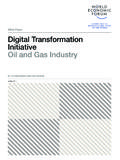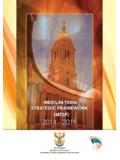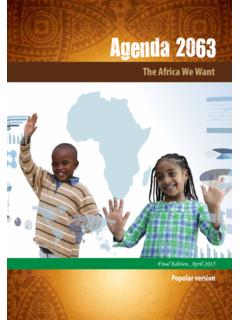Transcription of LEVERAGING AFRICAN PENSION FUNDS FOR FINANCING ...
1 LEVERAGING AFRICAN PENSION FUNDS FOR FINANCING INFRASTRUCTURE DEVELOPMENTM arch 2017 This paper builds on an earlier background paper prepared in consultation with the Office of the Special Adviser on Africa for the Third United Nations Conference on FINANCING for Development, July 13-16, 2015, Addis Ababa, s note: The Brookings Institution is a nonprofit organization devoted to independent research and policy solutions. Its mis-sion is to conduct high-quality, independent research and, based on that research, to provide innovative, practi-cal recommendations for policymakers and the public. The conclusions and recommendations of any Brookings publication are solely those of its author(s), and do not reflect the views of the Institution, its management, or its other scholars. Brookings recognizes that the value it provides is in its absolute commitment to quality, independence and impact.
2 Activities supported by its donors reflect this commitment and the analysis and recommendations are not deter-mined or influenced by any donation. A full list of contributors to the Brookings Institution can be found in the Annual Report at AuthorAmadou N. R. Sy is a nonresident senior fellow at the Africa Growth initiative at the Brookings :This report on LEVERAGING PENSION FUNDS for FINANCING Infrastructure Development in Africa has been prepared by Dr. Amadou Sy, nonresident senior fellow at the Brookings Institution. It is based on based on background work he conducted as a consultant for the United Nations Office of the Special Advisor on Africa (OSAA). The work was completed when Dr. Sy was senior fellow and director of the Brookings Africa Growth report has benefited from comments and suggestions provided by OSAA staff, especially Mr.
3 David Mehdi Hamam, Director; Ms. Beatrice Pacunega Manano, Chief, Programme Analysis and Monitoring Branch; Mr. Kavazeua Katjomuise, Senior Economic Affairs Officer; Mr. Ben Idrissa Ouedraogo, Programme Officer; Mr. Utku Teksoz, Programme Officer; Ms. Marieke Hounjet, Associate Economic Affairs Officer; also the support of Ms. Carol Sakubita, Staff Assistant; and Ms. Mary Nyumu, Team Assistant. The NEPAD Team namely: Mr. Symerre Grey-Johnson, Head, Regional Integration Infrastructure and Trade Programme (RIITP); Ms. Daphine Muzawazi, PIDA M&E and Program Support, RIITP; and Mr. Yusuf Coovadia, Transaction Advisor NEPAD Power Africa. The report was enriched by the official statements delivered by high ranking government officials, executives of PENSION FUNDS , as well as heads of United Nations organizations, international and regional organizations at the High-Level Meeting on LEVERAGING PENSION FUNDS for FINANCING Infrastructure Development in Africa organized jointly by the AFRICAN Union Commission, the Office of the Special Adviser on Africa and the Organization for Economic Cooperation and Development, at the margins of the Third International Conference on FINANCING for Development in Addis Ababa, Ethiopia.
4 Valuable comments were received from colleagues from the AFRICAN Union Commission s Department for Infrastructure and Energy and the OECD s Directorate for Financial Affairs. Thanks also to Christina Golubski for her editorial comments and Otito Greg-Obi for her research author is grateful to all for their holds a transformative power in our societies and economies. Through the construction of electric-ity, transportation, and telecommunications networks, we are able to power our homes and businesses, connect our producers to markets, and share information rapidly, boosting our trade, competitiveness, economic opportu-nities, and quality of life. So crucial is infrastructure to promoting our shared prosperity that it is featured in Goal 9 of the 17 Sustainable Development Goals (SDGs) of the 2030 Agenda Build resilient infrastructure, promote sustainable industrialization and foster innovation adopted at the historic September 2015 Sustainable Development Summit and Aspiration 2 of Agenda 2063, the AFRICAN Union s vision for Africa s transformation over the next five decades.
5 Regional institutions, including the AFRICAN Development Bank (AfDB), the New Partnership for Africa s Development (NEPAD), and the Economic Commission for Africa are actively supporting infra-structure development in the , meeting this goal will require decisive action as Africa s infrastructure needs remain immense: Only 30 per-cent of Africa s population has access to electricity, 34 percent has access to roads, and internet penetration rate is wobbly low, a mere 6 percent compared to 70-90 percent for other developing countries. In sub-Saharan Africa, the infrastructure deficit is particularly acute, with the poorest countries in Africa falling far below other low-income countries on all infrastructure-related indicators. To address these infrastructure gaps and fully achieve Goal 9 of the SDGs and Aspiration 2 of Agenda 2063, governments will need to accelerate and intensify efforts to mobilize domestic and external FINANCING resources for infrastructure development.
6 Sub-Saharan AFRICAN countries alone spent nearly $60 billion from their national budgets on infrastructure development in 2012. Although significant, this sum falls short of the estimated $93 billion needed to close the region s infrastructure gap completely, and explains the continuing bottlenecks in the region. So where can AFRICAN governments find the necessary funding to carry out these projects? What untapped and innovative sources can be leveraged toward Africa s infrastructure?Domestic public investments constitute the bulk of resources allocated toward infrastructure projects in sub-Saharan Africa, with tax revenues making up a large portion of these FUNDS . At the Third United Nations International Conference on FINANCING for Development held in July 2016 in Addis Ababa, Ethiopia, world lead-ers called for greater domestic resource mobilization focusing primarily on strengthening tax collection mecha-nisms and broadening tax bases to support infrastructure projects.
7 However, other domestic mechanisms for FINANCING infrastructure do exist. For example, PENSION FUNDS are able to set aside assets for investment, includ-ing in infrastructure, but these schemes are currently underutilized on the AFRICAN continent. While some experts argue that PENSION FUNDS are too risk averse to invest in risky, decades-long infrastructure projects, others con-tend that with the right governance, regulation, and instruments to assess and manage the risks associated with long-term investment in infrastructure, PENSION FUNDS could take on a greater role in transforming the continent s infrastructure report explores the key issues surrounding PENSION FUNDS as a source of FINANCING for AFRICAN infrastructure and makes a compelling case for reforming the continent s PENSION schemes so they can serve as an integral component of the global approach to meet Goal 9 of the SDGs and Aspiration 2 of Agenda 2063.
8 It begins by providing an overview of the gaps in AFRICAN infrastructure, as well as the financial resources available to support infrastructure development. In the sections that follow, it illustrates PENSION FUNDS untapped potential in the con-tinent, highlighting international experiences with PENSION FUNDS and the lessons learned from these cases. Then it concludes with policy recommendations for reforming PENSION schemes and fully capitalizing on the continent s favorable demographic sincerely,MR. KEMAL DERVI Vice President & Director Global Economy & Development Brookings InstitutionMR. MAGED ABDELAZIZU nder-Secretary-General andSpecial Adviser on AfricaDR. IBRAHIM ASSANE MAYAKIC hief Executive OfficerNEPAD AgencyTABLE OF CONTENTSI. Introduction ..1II. Sources of Infrastructure Finance in Africa ..7 Domestic FINANCING ..7 External FINANCING .
9 8 III. PENSION FUNDS Direct Investment in Infrastructure ..10 International experience ..10 AFRICAN PENSION FUNDS infrastructure investment ..12IV. Obstacles to PENSION FUNDS Investment in Infrastructure ..17A. PENSION systems environment, design, and performance ..19 Environment ..19 PENSION system design ..21 PENSION system performance ..23 PENSION reform ..27B. Governance, regulation, and supervision of PENSION FUNDS ..28C. Policy framework for investment in infrastructure ..30D. Infrastructure FINANCING instruments available to PENSION FUNDS ..31V. Conclusions and Policy Recommendations ..34 Appendix A: Overview of PENSION Systems in Selected Countries ..38 Botswana ..38 Egypt ..40 Namibia ..42 Nigeria ..44 South Africa ..46 Appendix B: AFRICAN PENSION Systems ..49 Appendix C: Institutional Investment in AFRICAN Infrastructure ..51 References.
10 53 LIST OF FIGURESF igure 1. Importance of PENSION FUNDS relative to the size of the economy in OECD countries, 2013 (in percent of GDP) ..11 Figure 2. Importance of PENSION FUNDS relative to the size of the economy in selected non-OECD countries, 2013 (in percent of GDP) ..13 Figure 3. Non-health public social protection expenditure on pensions and other benefits for older persons, and share of older population (65 and above) in total population (2010-2011) ..20 Figure 4. Old-age dependency ratio (ages 65+/15-64), 2010-2050 ..21 Figure 5. Labor force participation rate (% total population 15-56), 2000-2010 ..22 Figure 6. Effective PENSION coverage, by region, latest available year (%) ..25 LIST OF TABLEST able 1. AFRICAN PENSION FUNDS : Potential assets available for infrastructure ..15 Table 2. PENSION FUNDS : Infrastructure investment in percent of total assets (2012).

















